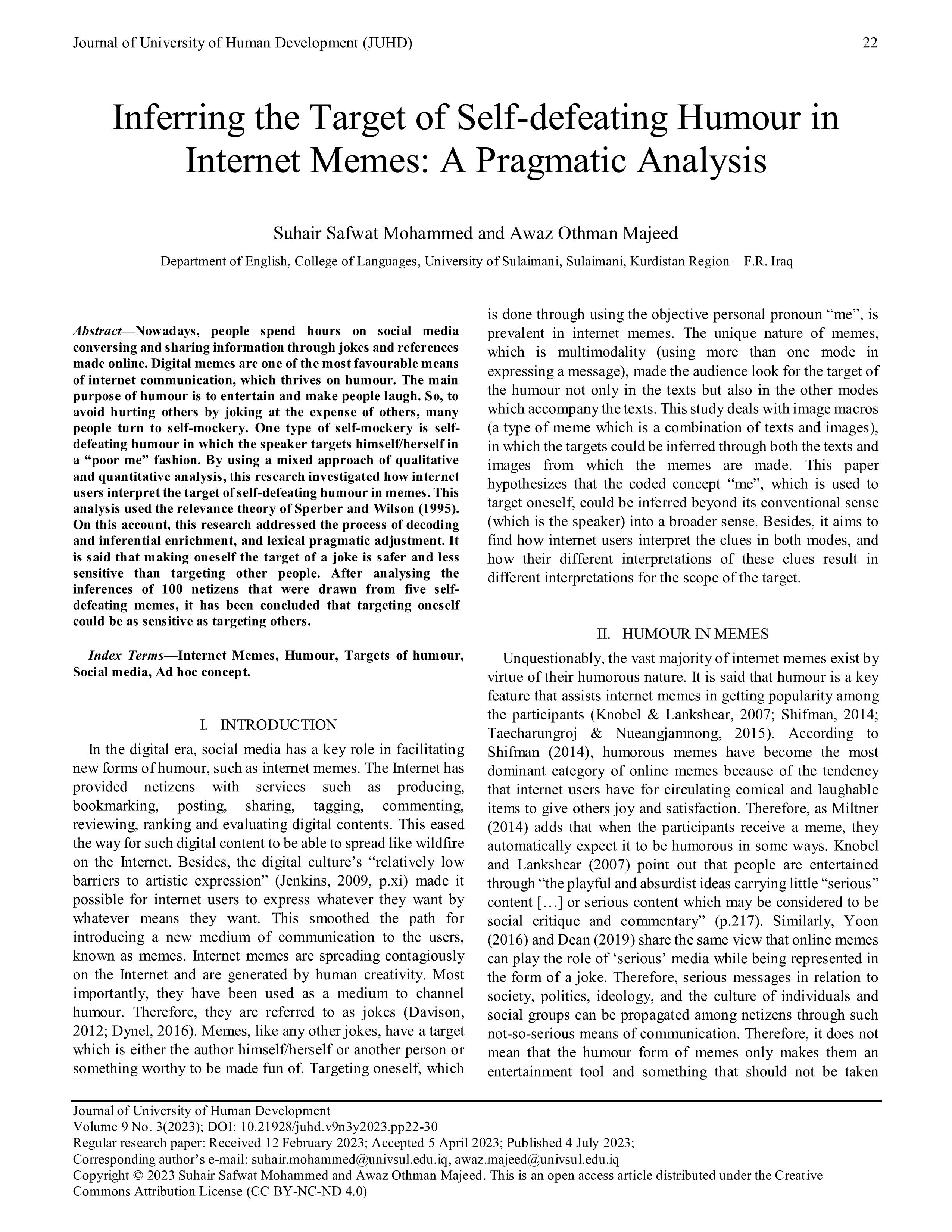Inferring the Target of Self-defeating Humour in Internet Memes: A Pragmatic Analysis
DOI:
https://doi.org/10.21928/juhd.v9n3y2023.pp22-30Keywords:
Internet Memes, Humour, Targets of humour, Social media, Ad hoc conceptAbstract
Nowadays, people spend hours on social media conversing and sharing information through jokes and references made online. Digital memes are one of the most favourable means of internet communication, which thrives on humour. The main purpose of humour is to entertain and make people laugh. So, to avoid hurting others by joking at the expense of others, many people turn to self-mockery. One type of self-mockery is self-defeating humour in which the speaker targets himself/herself in a “poor me” fashion. By using a mixed approach of qualitative and quantitative analysis, this research investigated how internet users interpret the target of self-defeating humour in memes. This analysis used the relevance theory of Sperber and Wilson (1995). On this account, this research addressed the process of decoding and inferential enrichment, and lexical pragmatic adjustment. It is said that making oneself the target of a joke is safer and less sensitive than targeting other people. After analysing the inferences of 100 netizens that were drawn from five self-defeating memes, it has been concluded that targeting oneself could be as sensitive as targeting others.
References
Afflerbach, K. A. (2015). Humorous developments: Ridicule, recognition, and the development of agency.
Allott, N., & Textor, M. (2012). Lexical pragmatic adjustment and the nature of ad hoc concepts. International review of pragmatics, 4(2), 185-208.
Boyd, D. M., & Ellison, N. B. (2007). Social network sites: Definition, history, and scholarship. Journal of computer‐mediated Communication, 13(1), 210-230.
Carston, R. (2002). Thoughts and Utterances. Oxford: Blackwell.
Carston, R., & Uchida, S. (2012). Relevance theory. Routledge companion to the philosophy of language, 163-176.
Catanescu, C., & Tom, G. (2001). Types of humor in television and magazine advertising. Review of Business-Saint Johns University, 22(1), 92-95.
Davison, P. (2012). The language of internet memes. The social media reader, 120-134.
Dawkins, R. (1976). 11. Memes: the new replicators. The selfish gene.
Dawkins, R. (2016). The Selfish Gene (4th ed., p. 544). Oxford University Press. (ISBN 13:9780198788607; ISBN 10: 0198788606).
Dean, J. (2019). Sorted for memes and gifs: Visual media and everyday digital politics. Political Studies Review, 17(3), 255-266.
Denisova, A. (2019). Internet memes and society: Social, cultural, and political contexts. Routledge.
Dynel, M. (2016). “I has seen Image Macros!” Advice Animals memes as visual-verbal jokes. International Journal of Communication, 10, 29.
Jenkins, H. (2009). Confronting the challenges of participatory culture: Media education for the 21st century (p. 145). The MIT Press.
Knobel, M., & Lankshear, C. (2007). Online memes, affinities, and cultural production. A new literacies sampler, 29, 199-227.
Martin, R. A., Puhlik-Doris, P., Larsen, G., Gray, J., & Weir, K. (2003). Individual differences in uses of humor and their relation to psychological well-being: Development of the Humor Styles Questionnaire. Journal of research in personality, 37(1), 48-75.
Milner, R. M. (2012). The World Made Meme: Discourse and Identity in Participatory Media. PhD Thesis. University of Kansas.
Miltner, K. M. (2014). “‘There’s no place for lulz on LOLCats’: The role of genre, gender, and group identity in the interpretation and enjoyment of an Internet meme.” First Monday 19(4).
Shifman, L. (2007). Humor in the age of digital reproduction: Continuity and change in internet-based comic texts. International Journal of Communication, 1(1), 23.
Shifman, L. (2014). Memes in Digital Culture. Cambridge, MA: The MIT Press.
Soh, W. Y. (2020). Digital protest in Singapore: the pragmatics of political Internet memes. Media, Culture & Society, 42(7-8), 1115-1132.
Soltanoff, S. M. (1994). Choosing to be amusing: assessing an individuals receptivity to therapeutic humor.
Sperber, D., & Wilson, D. (1986). Relevance: Communication and cognition (Vol. 142). Cambridge, MA: Harvard University Press.
Sperber, D., & Wilson, D. (1995). Relevance. Communication and Cognition. 2nd edition. Oxford: Blackwell.
Taecharungroj, V., & Nueangjamnong, P. (2015). Humour 2.0: Styles and types of humour and virality of memes on Facebook. Journal of Creative Communications, 10(3), 288-302.
VARONA, K. Y. (2016). CHAPTER FOUR THE ROLE OF INTERNET MEMES. Social Media in Asia: Changing Paradigms of Communication, 76.
Wilson, D., & Sperber, D. (2002). Relevance theory.
Yoon, I. (2016). Why is it not just a joke? Analysis of Internet memes associated with racism and hidden ideology of colorblindness. Journal of Cultural Research in Art Education, 33(1).
Yus, F. (2021). Pragmatics of humour in memes in Spanish. Spanish in Context, 18(1), 113-135.

Downloads
Published
How to Cite
Issue
Section
License
Copyright (c) 2023 Suhair Safwat Mohammed, Awaz Othman Majeed

This work is licensed under a Creative Commons Attribution-NonCommercial-NoDerivatives 4.0 International License.


